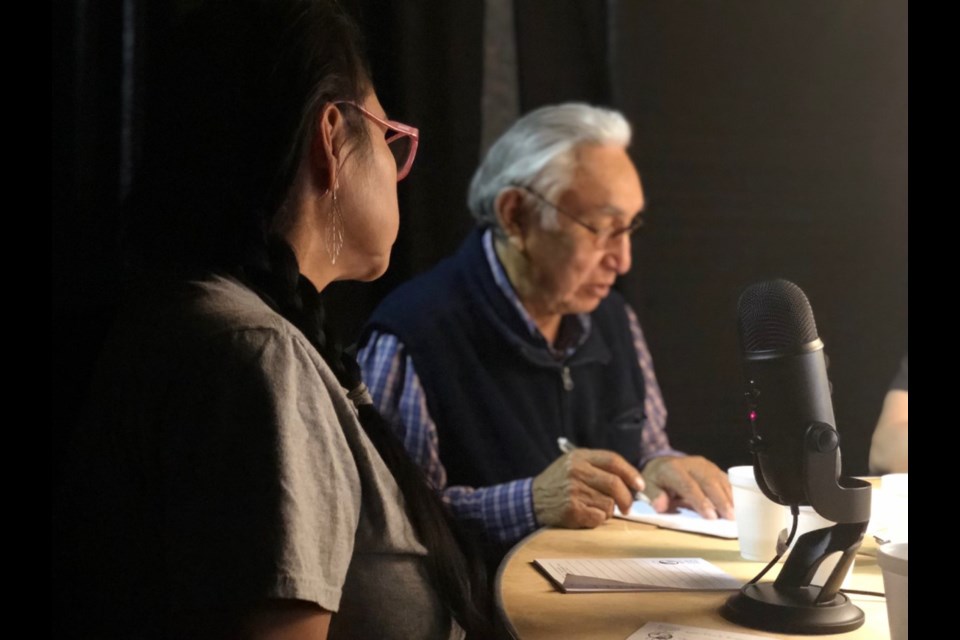A partnership between the Stoney Nakoda First Nation and the Language Conservancy (TLC) is aiming to preserve and restore the Stoney language through the creation of new educational resources.
Stoney Education Authority language and culture coordinator Cherith Mark said the initiative started in 2019 when one of the school board's language teachers in Morley approached TLC about creating classroom resources in the Stoney language.
Before the partnership began, Stoney language teachers were creating their own resources, and while their cause was noble, they found themselves struggling to teach the language effectively and in a consistent manner.
"They wanted something that all language teachers in our school district would be able to utilize," said Mark. "Most of us who know the language are oral speakers, so we kind of wanted some type of (written) resource that could also be used."
Stoney Education Authority and TLC – a U.S.-based non-profit organization that works with Native Americans and Indigenous Peoples to protect and revitalize their languages – agreed to collaborate after a representative visited Morley in 2019.
With the help of about 50 Stoney Nakoda First Nation elders from Chiniki, Wesley and Bearspaw, TLC helped to build a comprehensive Stoney dictionary through a two-week rapid word collection event at Stoney Nakoda Resort and Casino over September and October 2019.
"It all really was going to start with that," said TLC CEO and chairman Wilhelm Meya. "Once you have a good dictionary, it becomes the building block and the cornerstone of all the other materials you can build.
"It really helps stabilize the language because then there's a consistent spelling system, consistent meanings, and all of that provides the kind of credibility that learners really need."
Stations manned by TLC linguists were set up at the event, covering different Stoney word categories for what items one might find in their kitchen for example.
Elders tagged as many Stoney words and definitions as they could at each station.
After two weeks, they collected 14,000 words.
"That's the basic principle behind this approach that we have where we cover 1,700 categories that cover the entire spectrum of experiences of the tribe," said Meya. "It's an entire universe – almost like an encyclopedia of the experience."
It helps that TLC has worked extensively with Indigenous Peoples to preserve and restore the Dakota and Lakota languages, which are related to Stoney in the Siouan language family.
Stoney Nakoda First Nation and Stoney Education Authority classrooms are now beginning to see the tangible rewards of their efforts through the creation of levelled textbooks, colouring, alphabet and picture books, as well as learning apps.
Stoney Education Authority was able to fund the project, and the resources created from it, entirely through grants.
Mark said she believes the work they are doing is important not only for their collective identity as Stoney Nakoda people but also so they, as Indigenous people, can better adapt.
"As Indigenous people, we have to change along with the world," she said. "But we also need to preserve what we have, which is language and culture.
"It's really important to preserve those things because our languages are living things. Our language is always changing and evolving with the young speakers."
While working on the project, Mark said she's been learning older terms and phrases she had never heard before, often because they were cut short or abbreviated by her own generation and others before hers.
"We've always been an oral-speaking language," she said. "Our language also needs to be documented so we can keep track of these changes."
It's estimated there are about 3,000 speakers of the Stoney language. Most reside in Morley.
Stoney Nakoda First Nation member Corleigh Powderface, who has been involved since the first event, said for herself, the project has been about more than preservation; it's brought their community closer by trying to reach a common goal.
"It was an honour and a privilege to work with the whole community on this dictionary," she said. "And that brought great feelings to my heart to know that our community still exists, even though we do live apart.
“That is something I'm going to cherish forever.”
Recently, Nakoda Elementary School began bringing in Stoney Nakoda elders and knowledge keepers in a new organized initiative to pass on teachings of language, culture and traditions to the school's students in kindergarten through Grade 5.
Currently, a Level 1 textbook designed for non-Stoney speakers is available. Levels two and three are expected to roll out in the new year.
A free mobile app called StoneyDictionary is available for download and Powderface said she hopes people outside the Stoney Nakoda community will express some interest in learning too, for the sake of truth and reconciliation.
"We no longer want to be just this community that's living alongside the Bow River," she said. "We want to be heard now and we would like to have somebody, even from Cochrane, say âba wathtech, which means 'good day.'
"For me, that's one of the steps toward truth and reconciliation because that person actually asked, ‘How are you?’"



